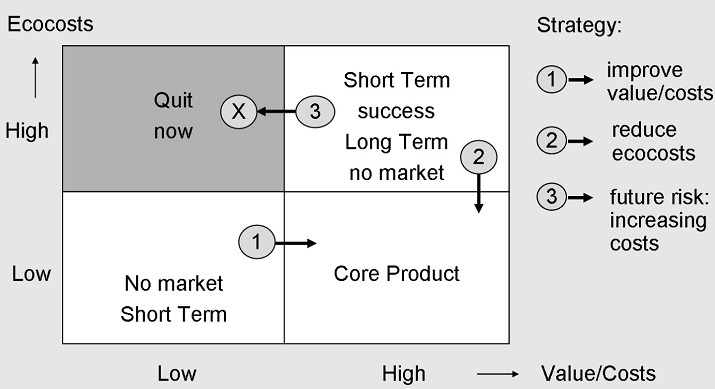
 Data Structure
Data Structure Networking
Networking RDBMS
RDBMS Operating System
Operating System Java
Java MS Excel
MS Excel iOS
iOS HTML
HTML CSS
CSS Android
Android Python
Python C Programming
C Programming C++
C++ C#
C# MongoDB
MongoDB MySQL
MySQL Javascript
Javascript PHP
PHP
- Selected Reading
- UPSC IAS Exams Notes
- Developer's Best Practices
- Questions and Answers
- Effective Resume Writing
- HR Interview Questions
- Computer Glossary
- Who is Who
Passive VS Active Portfolio Strategy
Introduction
We have examined the definitions, characteristics, advantages, and disadvantages of active and passive portfolio strategies in this post. With an active portfolio strategy, portfolio managers actively choose securities in an effort to outperform the market. The objective of a passive portfolio approach, on the other hand, is to mimic the performance of a market index with the least amount of intervention possible.
General example of Product Portfolio

Define Active Portfolio Strategy
In an active portfolio strategy, portfolio managers actively choose investments in an effort to outperform a market benchmark or index. In order to provide larger returns than passive investment strategies entail extensive study, analysis, and continual monitoring of the portfolio's assets.
To take advantage of market inefficiencies and new possibilities, active portfolio managers choose specific securities, modify asset allocation, and practice market time. This approach actively manages the portfolio based on current market conditions and investment outlooks in an effort to provide higher risk-adjusted returns.
Advantages and Disadvantages of Active Portfolio Strategy
Advantages
Possibility of Outperformance By striving to outperform the market, active portfolio managers offer the chance for larger returns than passive strategies.
Flexibility and Adaptability Active methods permit revisions based on market circumstances, economic projections, and investment possibilities, providing the opportunity for prompt portfolio adjustments.
Individualization An increasingly personalized approach is made possible by active portfolio management, which enables investors to match their assets to particular objectives, risk tolerances, and preferences.
Disadvantages
Higher expenses Active strategies frequently engage in trading and research, which results in higher management fees and possibly transaction expenses.
Underperformance Risk Active managers have the risk of underperforming the market on a consistent basis, which would result in lower returns than passive strategies.
Behavioral Biases Emotional and cognitive biases may affect active methods, which may result in less-than-ideal investing choices.
Investor time and resources are needed for active portfolio management, which necessitates continual study, analysis, and monitoring.
Define Passive Portfolio Strategy
Investors that use a passive portfolio strategy try to match the performance of a certain market index or benchmark. Instead of actively choosing individual stocks, it entails building a portfolio whose asset allocation and weighting closely match those of the selected index.
Exchange-traded funds (ETFs) that track the target index are frequently used to implement passive techniques. Instead of actively making decisions to surpass the benchmark, the objective is to achieve a return that is comparable to it. Compared to active techniques, passive portfolio strategies frequently have lower expenses and lower portfolio turnover.
Advantages and Disadvantages of Passive Portfolio Strategy
Advantages
Lower expenses Compared to active strategies, passive strategies often have lower management fees and transaction expenses.
Diversification Passive portfolios give investors access to a wide range of markets, which lowers the risk involved in particular stocks.
Consistent Returns Passive methods seek to provide long-term, consistent, market-like returns by closely matching the target index
Disadvantages
Limited Flexibility The capacity to adjust to shifting market conditions or take advantage of particular investment opportunities is limited with passive techniques.
Lack of Customization Since the portfolio's composition follows the predetermined benchmark, investors require more control over it.
Underperformance Risk In certain market conditions or when the index produces poor returns, passive strategies may perform worse than active ones.
Similarities Between Passive and Active Portfolio Strategy
Although the investment methodologies used by passive and active portfolio strategies are different, there are some similarities between the two
Long-run Perspective Although the approaches used in the two strategies are different, both aim to provide returns over the long run.
Portfolio Diversification Both strategies acknowledge the value of diversification in reducing risk and possibly increasing returns.
Portfolio Monitoring Although the frequency and level of involvement may differ, both techniques call for constant evaluation of the portfolio's performance and market conditions
Risk Management Despite having distinct methodologies, both systems view risk management as a vital component. While passive strategies rely on diversification and monitoring the risk profile of the market index, active strategies may incorporate more aggressive risk management techniques.
Investor Objectives Despite using various methods to accomplish these objectives, both strategies aim to match investment choices with the investor's objectives, risk tolerance, and time horizon.
Differences Between Passive and Active Portfolio Strategy
There are several important ways that passive and active portfolio methods diverge.
Categories |
Active Portfolio Strategies |
Passive Portfolio Strategies |
|---|---|---|
Market |
Active strategies seek to outperform the market by active decision-making. |
Passive strategies seek to imitate the performance of a market index. |
Security Selection |
Active strategies entail selecting specific securities based on market projections, research, and analysis. |
passive strategies rely on broad market exposure through index funds or ETFs. |
Portfolio Turnover |
Active methods may require more frequent buying and selling of securities. |
Passive strategies often have lower portfolio turnover because they attempt to track the index. |
Costs |
Active strategies have higher costs. |
Due to their passive nature, passive strategies often have lower costs than active strategies, which typically have greater expenditures for things like research, trading, and management fees. |
Risk profile |
Active strategies may carry additional risks due to active security selection and market timing. |
Passive strategies involve market risk due to their close index tracking. |
Returns |
Active strategies seek to outperform the benchmark, potentially providing greater or lower returns based on the investment choices made. |
Passive strategies strive to replicate the performance of the selected benchmark. |
Overall, there are the most differences between the level of active decision-making and the strategy for reaching investing goals.
Conclusion
Both approaches have much in common, like a long-term outlook, portfolio diversification, and risk management. Their approaches, securities choices, prices, portfolio turnover, risk profiles, and anticipated returns, however, are different.
Understanding these variations is essential to selecting the best strategy based on your investing goals and preferences.
FAQs
Qns 1. What is an active portfolio strategy?
Ans. To outperform the market, an active portfolio strategy uses individual security selection and active decision-making.
Qns 2. What is a passive portfolio strategy?
Ans. A passive portfolio approach uses the least amount of intervention possible to mimic the performance of a market index.
Qns 3. What are the pros of active portfolio strategy?
Ans. The potential for higher returns, greater choice in the securities chosen, and the capacity to react to market developments are all features of an active portfolio strategy.

